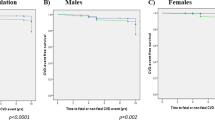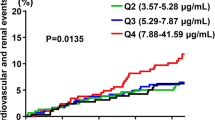Abstract
Coexistence of hypertension and diabetes mellitus (DM) increases the risk of cardiovascular disease. However, factors associated with future development of DM have not been well elucidated in patients already having essential hypertension. This study prospectively included 168 patients (mean age 41 ± 7 years, 112 men) with essential hypertension. All patients did not have DM and vascular or renal complications initially. Baseline demographic data, blood pressure, body mass index, and antihypertensive agents were carefully evaluated and serum high-sensitivity C-reactive protein (hsCRP) was measured at the beginning of the study. All of the patients were followed for at least 6 months. The study endpoint was occurrence of new DM. After a mean follow-up period of 32 ± 10 months, 22 subjects (13.1%) developed new DM. Patients with new DM had higher baseline glucose (105.2 ± 11.8 vs 94.2 ± 8.0 mg/dl, P < 0.001), triglyceride level (213.7 ± 112.4 vs 155.6 ± 83.2 mg/dl, P = 0.04), log hsCRP (0.31 ± 0.44 vs 0.19 ± 0.25 mg/dl, P = 0.016), and lower high-density lipoprotein (40.2 ± 7.8 vs 46.6 ± 14.4 mg/dl, P = 0.045). Total cholesterol, low-density lipoprotein, homeostasis model assessment index, and adiponectin were not different in patients with or without new DM. Among antihypertensive agents, only use of β-blocker was significantly associated with new DM (P = 0.008). Multivariate Cox regression analysis showed log hsCRP (hazard ratio [HR] 9.77, 95% confidence interval [CI] 2.97-32.10, P < 0.001), age (HR 1.21, 95% CI 1.06–1.38, P = 0.004), and baseline glucose level (HR 1.11, 95% CI 1.06–1.15, P < 0.001) to be independent predictors for occurrence of new DM. High-sensitivity CRP was an independent factor for future development of DM in essential hypertensive patients. Increased inflammation might have a key role in the pathogenesis of DM in hypertension.
Similar content being viewed by others
References
Wolf-Maier K, Cooper RS, Banegas JR, Giampaoli S, Hense HW, Joffres M, Kastarinen M, Poulter N, Primatesta P, Rodriguez-Artalejo F (2003) Hypertension prevalence and blood pressure levels in 6 European countries, Canada, and the United States. JAMA 289:2363–2369
Pitsavos C, Chrysohoou C, Panagiotakos DB, Lentzas Y, Stefanadis C (2008) Andominal obesity and inflammation predicts hypertension among prehypertensive men and women: the ATTICA study. Heart Vessels 23:96–103
Holcomb SS (2005) Selection of antihypertensive agents in patients at risk for diabetes. Curr Hypertens Rep 7:461–465
Kasai T, Miyauchi K, Kajimoto K, Kubota N, Kurata T, Daida H (2008) Influence of diabetes on >10-year outcomes after percutaneous coronary intervention. Heart Vessels 23:149–154
Gress TW, Nieto FJ, Shahar E, Wofford MR, Brancati FL (2000) Hypertension and antihypertensive therapy as risk factors for type 2 diabetes mellitus: Atherosclerosis Risk in Communities Study. N Engl J Med 342:905–912
The Diabetes Prevention Program (1999) Design and methods for a clinical trial in the prevention of type 2 diabetes. Diabetes Care 22:623–634
Mansour AA, Al-Jazairi MI (2007) Predictors of incident diabetes mellitus in Basrah, Iraq. Ann Nutr Metab 51:277–280
Zillich AJ, Garg J, Basu S, Bakris GL, Carter BL (2006) Thiazide diuretics, potassium, and the development of diabetes: a quantitative review. Hypertension 48:219–224
Bangalore S, Parkar S, Grossman E, Messerli FH (2007) A meta-analysis of 94,492 patients with hypertension treated with beta blockers to determine the risk of new-onset diabetes mellitus. Am J Cardiol 100:1254–1262
Scheen AJ (2004) Renin-angiotensin system inhibition prevents type 2 diabetes mellitus. Part 1. A meta-analysis of randomised clinical trials. Diabetes Metab 30:487–496
Mancia G, Grassi G, Zanchetti A (2004) New-onset diabetes and antihypertensive drugs. J Hypertens 24:3–10
Bassuk SS, Rifai N, Ridker PM (2004) High-sensitive C-reactive protein. Curr Probl Cardiol 29:439–493
Ridker PM (2007) C-reactive protein and the prediction of cardiovascular events among those at intermediate risk. J Am Coll Cardiol 49:2129–2138
Bautista LE, Atwood JE, O’Malley PG, Taylor AJ (2004) Association between C-reactive protein and hypertension in healthy middle-aged men and women. Coron Artery Dis 15:331–336
Tsai WC, Lin CC, Huang YY, Chen JY, Chen JH (2007) Association of increased arterial stiffness and inflammation with proteinuria and left ventricular hypertrophy in non-diabetic hypertensive patients. Blood Press 16:270–275
Pfutzner A, Forst T (2006) High-sensitivity C-reactive protein as cardiovascular risk marker in patients with diabetes mellitus. Diabetes Technol Ther 8:28–36
Lu L, Pu LJ, Xu XW, Zhang Q, Zhang RY, Zhang JS, Hu J, Yang ZK, Lu AK, Ding FH, Shen J, Chen QJ, Lou S, Fang DH, Shen WF (2007) Association of serum levels of glycated albumin, C-reactive protein and tumor necrosis factor-alpha with the severity of coronary artery disease and renal impairment in patients with type 2 diabetes mellitus. Clin Biochem 40:810–816
Liu S, Tinker L, Song Y, Rifai N, Bonds DE, Cook NR, Heiss G, Howard BV, Hotamisligil GS, Hu FB, Kuller LH, Manson JE (2007) A prospective study of inflammatory cytokines and diabetes mellitus in a multiethnic cohort of postmenopausal women. Arch Intern Med 167:1676–1685
Kondo N, Nomura M, Nakaya Y, Ito S, Ohguro T (2005) Association of inflammatory marker and highly sensitive C-reactive protein with aerobic exercise capacity, maximum oxygen uptake and insulin resistance in healthy middle-aged volunteers. Circulation J 69:452–457
Freeman DJ, Norrie J, Caslake MJ, Gaw A, Ford I, Lowe GD, O’Reilly DS, Packard CJ, Sattar N (2002) C-reactive protein is an independent predictor of risk for the development of diabetes in the West of Scotland Coronary Prevention Study. Diabetes 51:1596–1600
Tsai WC, Lin CC, Chen JY, Huang YY, Lee CH, Li WT, Weng CM, Chen JH (2008) Association of adiponectin with procollagen type I carboxyterminal propeptide in non-diabetic essential hypertension. Blood Press 17:233–238
Emoto M, Nishizawa Y, Maekawa K, Hiura Y, Kanda H, Kawagishi T, Shoji T, Okuno Y, Morii H (1999) Homeostasis model assessment as a clinical index of insulin resistance in type 2 diabetic patients treated with sulfonylureas. Diabetes Care 22:818–822
Biondi-Zoccai GG, Abbate A, Liuzzo G, Biasucci LM (2003) Atherothrombosis, inflammation, and diabetes. J Am Coll Cardiol 41:1071–1077
Vozarova B, Weyer C, Lindsay RS, Pratley RE, Bogardus C, Tataranni PA (2002) High white blood cell count is associated with a worsening of insulin sensitivity and predicts the development of type 2 diabetes. Diabetes 51:455–461
Ford ES (2002) Leukocyte count, erythrocyte sedimentation rate, and diabetes incidence in a national sample of U.S. adults. Am J Epidemiol 155:57–64
Rizzo M, Corrado E, Coppola G, Muratori I, Mezzani A, Novo G, Novo S (2009) The predictive role of C-reactive protein in patients with hypertension and subclinical atherosclerosis. Intern Med J 39:539–545
Schillaci G, Pirro M, Gemelli F, Pasqualini L, Vaudo G, Marchesi S, Siepi D, Bagaglia F, Mannarino E (2003) Increased C-reactive protein concentrations in never-treated hypertension: the role of systolic and pulse pressure. J Hypertens 21:1841–1846
Michos ED, Blumenthal RS (2009) Prevalence of low-density lipoprotein cholesterol with elevated high sensitivity C-reactive protein in the U.S. J Am Coll Cardiol 53:931–935
Ge CJ, Lu SZ, Chen YD, Wu XF, Hu SJ, Ji Y (2008) Synergistic effect of amlodipine on blood pressure, left ventricular remodeling, and C-reactive protein in hypertensive patients with primary hypercholesterolemia. Heart Vessels 23:91–95
Futai R, Ito T, Kawanishi Y, Terasaki F, Kitaura Y (2009) Olmesartan ameliorates myocardial function independent of blood pressure control in patients with mild-to-moderate hypertension. Heart Vessels 24:294–300
Rytter E, Vessby B, Asgard R, Johansson C, Sjodin A, Abramsson-Zetterberg L, Moller L, Basu S (2009) Glycemic status in relation to oxidative stress and inflammation in well-controlled type 2 diabetes subjects. Br J Nutr 101:1423–1426
Kondo N, Nomura M, Nakaya Y, Ito S, Ohguro T (2005) Association of inflammatory marker and highly sensitive C-reactive protein with aerobic exercise capacity, maximum oxygen uptake and insulin resistance in healthy middle-aged volunteers. Circulation J 69:452–457
Bangalore S, Parkar S, Grossman E, Messerli FH (2007) A meta-analysis of 94,492 patients with hypertension treated with beta blockers to determine the risk of new-onset diabetes mellitus. Am J Cardiol 100:1254–1262
Ferrannini E, Buzzigoli G, Bonadonna R, Giorico MA, Oleggini M, Graziadei L, Pedrinelli R, Brandi L, Bevilacqua S (1987) Insulin resistance in essential hypertension. N Engl J Med 317:350–357
Lissner L, Bengtsson C, Lapidus L, Kristjansson K, Wedel H (1992) Fasting insulin in relation to subsequent blood pressure changes and hypertension in women. Hypertension 20:797–801
Taittonen L, Uhari M, Nuutinen M, Turtinen J, Pokka T, Akerblom HK (1996) Insulin and blood pressure among healthy children: cardiovascular risk in young Finns. Am J Hypertens 9:194–199
Gensini GF, Gori AM, Dilaghi B, Rostagno C, Gaw A, Blanco-Colio LM, de Teresa E, Egido J, Farsang C, Leiter LA, Martineau P, Nozza A, Langer A (2009) Effect of atorvastatin on circulating hsCRP concentrations: A sub-study of the Achieve Cholesterol Targets Fast with Atorvastatin Stratified Titration (ACTFAST) study. Int J Cardiol (Epub ahead of print)
Author information
Authors and Affiliations
Corresponding author
Additional information
These two authors contributed equally to this work.
Rights and permissions
About this article
Cite this article
Weng, CM., Chou, CH., Huang, YY. et al. Increased C-reactive protein is associated with future development of diabetes mellitus in essential hypertensive patients. Heart Vessels 25, 386–391 (2010). https://doi.org/10.1007/s00380-009-1218-2
Received:
Accepted:
Published:
Issue Date:
DOI: https://doi.org/10.1007/s00380-009-1218-2




